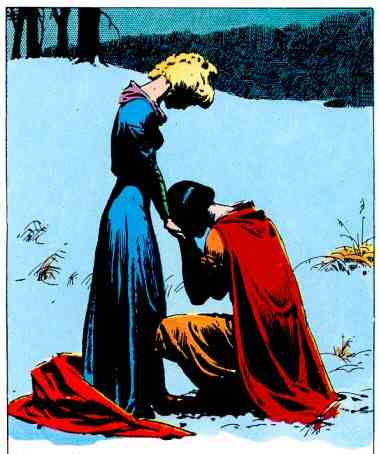Post Content
Prince Valiant, 8/8/04

Click here to view the full-sized comic in a new window.
I made a cheap shot last week when I cited Prince Valiant in an entry about the comics and “failed” classicists (though as a failed classicist myself, it was largely meant to be self-deprecating). As a well-informed but anonymous reader pointed out, the storylines for Prince Valiant are written by John Cullen Murphy, a medieval history major in college and current managing editor for the Atlantic, the hem of which publication’s robes I am not worthy to touch. Prince Valiant is in fact one of my great, non-ironic pleasures in the comics. Back when I was in grad school, in the waning days of the Clinton administration, my specialty was in what was then trendily called “the Late Antique” (no doubt it has a different name now), which covers very broadly the period from about the third century A.D. to about the seventh. It’s later than the Ancient Rome of I, Claudius, and it’s earlier than the knights-in-armor-and-damsels-in-distress middle ages; and so, while burdened with the dire poverty, grinding workload, and blighted social life that afflict all graduate students, I also had the additional problem of describing to normal human beings what the hell it was I actually studied.
Now I wish that I had been familiar with Prince Valiant then, because if I had, I just could have said, airily, “Oh, you know, it’s the stuff that happens in Prince Valiant.” In a country where anything that happened before World War II is generally considered ancient history, in the comics pages every Sunday we have a strip dedicated to goings-on sometime in the middle of the 500s A.D. While of course the characters’ adventures happen more or less outside the realm of real history, in my several years of following it I’ve yet to spot any real historical goofs.
One thing I’ve noted over time is the absence of any references to the magic and wizardry that most people associate with the time of King Arthur. In addition, although the characters live in a world that is obviously Christian (Galan is seeking the Holy Grail, after all, and has met with the Pope on his quest), that aspect is significantly underplayed. The current action features a hermit on the spot where Moses supposedly received the Ten Commandments reading from an unnamed “sacred book.” He tells the story of the Assyrian seige of Jerusalem from 2 Kings 18-19 — except that where the Old Testament has the Assyrian army struck down by an angel of God, our hermit attributes the victory to the King of Judah’s ingenuity in blocking up a spring. One imagines that the people who are up in arms about creeping secular humanism in the funnies are shooting off angry letters to the editor about this comic (written by a major player in the East Coast liberal media elite, no less!). Personally, I’m just glad to have a counterweight to Johnny Hart.
Of course, Prince Valiant is beautifully drawn, too. It’s impossible to find current strips online, though, which is why I haven’t commented on it earlier. I ended up scanning this one from the paper myself, cutting it up and reassembling in with image editing software, which was a big pain in the ass. So I insist rather forcefully that you click on the link to the full-sized comic above and appreciate the artwork, particularly in the dark and moody middle panel.





